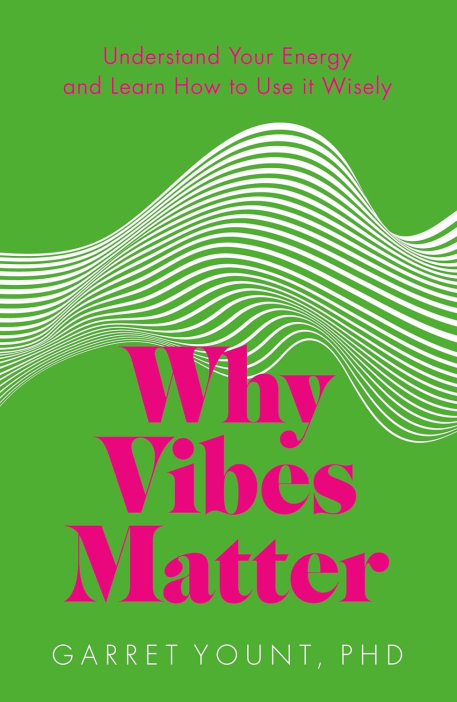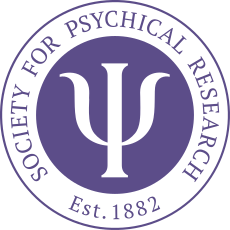
Reviewed by Nemo C. Mörck
The author, Garret Yount, is a biologist at the Institute of Noetic Sciences (IONS). Why Vibes Matter is his first book and he thanks the author Theresa Cheung for encouraging him to write it. Initially, Yount notes: “In disparate cultures across the globe, subtle energy vibes are accepted as part of everyday life ...” but they cannot “be measured by scientific instruments” so he has presented himself with a problem. Yount has done experiments with healers and is familiar with texts concerning energies. He writes “... vibes affect us, they steer our life choices and influence how we relate to those around us, and this subtle energy can also be used in healing and to balance the body.” (It seems reasonable to wonder whether all these things truly have the same causes). In modern language, vibing with someone means getting along and enjoying each other’s company. Facial expressions etc. can convey “conscious vibes” but Yount is more interested in “subconscious vibes” that seem hard to define yet affect us all.
Admittedly, I would place this book in the New Age section, but Yount is a scientist, writing with laymen in mind. However, he provides references and recommends further reading. Yount argues that we all send out vibes, he means not just by how we dress and act but also unconsciously. I have had my blood pressure measured several times this year and was told that the result can vary depending on who the doctor is (experimenter effect), presumably also depending on the vibes.
Yount relates that our bodies generate electromagnetic fields “like an invisible area of low-level radiation coming from the body that can be detected by sensitive instruments in a lab” and notes that researchers at HeartMath Institute have investigated this. Apparently, our electromagnetic fields are related our mood, and can affect others. Yount suggests that “the intention to heal, might also cause changes” in our electromagnetic fields, but the evidence cited is inconclusive.
He writes: “I don’t worry about how qigong works when I’m not in the lab. When I’m practicing qigong meditation, I can feel sensations and I experience benefits” but does not elaborate. However, he provides two exercises that should allow the reader to feel good vibes.
Yount goes on to cover neural coupling which suggests that brains can get in sync, he also covers mirror neurons. Tantric sex practices are also mentioned but Yount acknowledges that he is not aware of any research on whether subtle energy vibes are transferred: “There is also no research refuting this claim.” He provides some tips for tantric sex.
His background as a biologist shines through in his overviews. Yount also seems enthusiastic and fascinated by the subjects he covers, such as oxytocin. Yount comes closer to psychical research when he writes about psychic connections, relates a personal experience, and covers the newspaper article “Can your sixth sense tell when a loved one has died miles away?” (Knight, 2011). However, he does not really connect it to the psychical research literature. Yount has a different goal and recommends Emotional Freedom Technique (EFT): “Our team at IONS conducted the first randomized controlled trial of EFT, measuring a physiological biomarker of stress before and after treatment” (Church, et al., 2012).
Yount covers the feeling of being stared at (scopesthesia). He notes that Prof. E.B. Titchener wrote about it, in 1898, later John E. Coover, at Stanford University, conducted an experiment in 1913. Most research on the phenomenon is more recent, and he covers the rather well known collaboration between Marilyn Schlitz and Richard Wiseman (Schlitz, et al., 2006). Yount also writes about Cleve Backster’s research: “He reported that plants could react not only when they were harmed, but also when a person just threatened to harm them – as if they could sense the emotions of people. He also reported that one of his plants really didn’t like the mail carrier.” Yount was part of a group that was inspired to carry out a new study together with Backster: “This experience left a deep impression on me.” However, he acknowledges: “I cannot offer it as definitive proof that the isolated cells have consciousness and we had captured evidence of them responding to attention because we had not set up rigorous experimental procedures ...” It is not clear when the experiment was carried out or if the results were published.
Yount goes on to cover a study by Schlitz and Dean Radin (2005). They recruited pairs of participants, one acting as receiver and one as sender of either good or bad vibes. The receivers’ reactions were measured with electrogastrography. The results were statistically significant. Yount regards this as “a strong indication that the gut brain can receive vibes sent by a distant person” and recommends the Loving-Kindness Meditation.
He returns to psychical research by writing about places having different vibes.
The theory of emotional residue posits that people’s thoughts and emotions can somehow leave traces of subtle energy in the physical environment (also known as an “energy trace”), which can later influence others or be sensed by others.
Yount once found himself being “only one presenting negative results” at a meeting about energy medicine research. Prof. William Tiller “suggested that the obvious reason that I could not get replicable results with these healers was that my laboratory was full of bad vibes, due to the concurrent experiments that I was running in the same space involving chemotherapy and radiation.” With this in mind Yount conducted another study with the help of Radin and this time they were able to report statistically significant results (Radin, et al., 2004). The Global Consciousness Project is also briefly covered, but Yount does not acknowledge the controversy concerning how the results should be interpreted.
Belief in some kind of emotional residue is common and Yount notes: “Some states in the US have laws that home sellers must disclose if there has been a death on the property within a certain time period.” In response to this people offer smudging “traditionally a sacred ceremony where herbs are burnt to cleanse the subtle energies” (Haughney, 2011). Some ghost hunters also use this (e.g., Ritson, 2008/2020). Yount explains what to do and also covers Feng Shui.
Psychical researchers are probably more interested in his chapter about haunted places. Yount draws attention to an old report about a haunting that seemed to have had a natural cause – a leaking hot-air furnace (Schneider, 1913). He notes that, more recently, Carrie Poppy (2017) has spoken about the effects of carbon monoxide poisoning. Yount also briefly covers Michael Persinger’s research, that suggested that magnetic stimulation induced under laboratory conditions might cause “experiences attributed to visitations by ghosts and other ephemeral phenomena” but this is more controversial than his overview shows. Likewise, more scepticism is warranted concerning the possible connection between naturally occurring magnetic fields or infrasound and experiences suggestive of a haunting (Braithwaite, 2008; Braithwaite & Townsend, 2006).
In another chapter Yount focuses on places with positive vibes, such as Barcelona’s Basílica de la Sagrada Família, and later also from nature. He also briefly covers psychedelics, although Yount is positive, he also includes warnings. In addition, there is a long Note/Disclaimer on the copyright page letting the reader know that the publisher cannot be held responsible for the result of the various exercises Yount outlines. Eventually, Yount states:
This book has given you a behind-the-scenes knowledge of vibes and some simple tools for harnessing them. It’s time for you now to explore your experience of vibes more deeply and unlock the mysteries of how our minds influence the physical world and how we can transcend the limitations of space and time.
Why Vibes Matter is a short pleasant book. However, as noted, I have some concerns about Garret Yount’s coverage of research. More generally, I sense that Yount ends up conflating the mysterious vibes with more easily identifiable forces. That said, I recognise that I was not the intended reader. I believe the more spiritual, willing to experiment with meditation techniques and try the exercises he recommends, will find the book more valuable. Yount has written with laymen in mind and it is easy to follow his arguments. He also ends each chapter with a summary.
References
Braithwaite, J. (2008). Putting magnetism in its place: A critical examination of the weak-intensity magnetic field account for anomalous haunt-type experience. Journal of the Society for Physical Research, 82(890), 34-50.
Braithwaite, J., & Townsend, M. (2004). Good vibrations: The case for a specific effect of infrasound in instances of anomalous experience has yet to be empirically demonstrated. Journal for the Society of Psychical Research, 70(885), 211-224.
Church, D., Yount, G., & Brooks, A. J. (2012). The effect of Emotional Freedom Techniques on stress biochemistry: A randomized controlled trial. Journal of Nervous & Mental Disease, 200(10), 891-896.
Haughney, C. (2011, 4 January). Before move-in day, evicting the old auras. New York Times https://www.nytimes.com/2011/01/04/nyregion/04appraisal.html
Knight, K., 15 December). Can your sixth sense tell when a loved one has died miles away? DailyMail https://www.dailymail.co.uk/femail/article-2074247/Can-sixth-sense-tell-loved-died-miles-away.html
Poppy, C. (2017, 27 March). A scientific approach to the paranormal.
https://www.ted.com/talks/carrie_poppy_a_scientific_approach_to_the_paranormal
Radin, D. I., & Schlitz, M. J. (2005). Gut feelings, intuition, and emotions: An exploratory study. Journal of Alternative & Complementary Medicine, 11(1), 85–91.
Radin, D., Taft, R. J., & Yount, G. (2004). Effects of healing intention on cultured cells and truly random events. Journal of Alternative & Complementary Medicine, 10(1), 103-112. https://doi.org/10.1089/107555304322849020
Ritson, D. W. (2020). The South Shields poltergeist. The History Press. (Original work published 2008).
Schneider, F. (1913). An investigation of a “haunted” house. Science, 37(958), 711-712. https://doi.org/10.1126/science.37.958.711
Schlitz, M., Wiseman, R., Watt, C., & Radin, D. (2006). Of two minds: Sceptic-proponent
collaboration within parapsychology. British Journal of Psychology, 97(3), 313–322. https://doi.org/10.1348/000712605X80704

